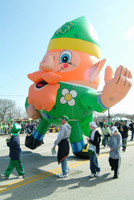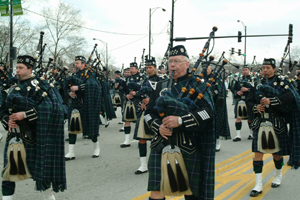For many Peorians and others around the country, the Irish holiday is best celebrated at the city’s annual parade surrounded by family and friends who follow it up with great food and green-colored brew. But the true Irish bloods hold the holiday to its religious heritage by paying homage to Maewyn Succat, who was later named Saint Patrick after becoming a priest in the 5th century.
According to the U.S. Census Bureau, over 34 million Irish Americans claim Irish ancestry, about nine times the number of people in Ireland, which numbered over four million in 2003. Irish is the nation’s second most frequently reported ancestry, trailing only German ancestry. Illinois also ranks in the top 10 states with the most Irish Americans, settling in at the number five slot. Because about one in four Americans can trace their ancestry to Ireland, many people are not surprised to learn that 19 U.S. Presidents claimed Irish heritage, one-third of the American troops in the Revolutionary War were Irish and nine of the 56 men who signed the Declaration of Independence were also Irish Americans. Because of such a deeply-rooted role in America’s history, Congress declared March Irish-American Heritage month in 1995.
The holiday pays tribute to the Catholic Christian missionary St. Patrick who was, ironically, a native of Britain. As the story goes, he was brought to Ireland against his will at the age of 16 and then sold as a slave. After being forced to work for six years, he escaped and returned to his family in Britain. St. Patrick then followed in his father’s footsteps and entered the church, eventually becoming a priest. His religious education led him back to the Emerald Isle where he spread the Christian faith for the next 30 years. Two centuries later, he was deemed a patron saint of Ireland. A five-day festival is now held in Ireland and on March 17, a religious holiday in Ireland, most businesses are closed. According to the St. Patrick’s 2007 Festival website, from March 15 to March 19, music, street theater, family carnivals, comedy, street performances, dances, a treasure hunt, night spectacles, about 4000 performers and one million spectators will all be part of the biggest celebration in Ireland. For more information on travel and accommodations during the Irish festival, visit www.stpatricksday.ie/cms/home.html.

In the United States, the holiday parades began as a political event. Irish immigrants, originally discriminated against and heavily resented in America, would gather together and celebrate their culture with parades in cities throughout the country. Around the mid-18th century, New York’s St. Patrick’s Day parade was kicked off by area Irish and is considered the longest-running St. Patrick’s Day parade. Now led by the U.S. 69th Infantry Regiment, the Big Apple’s parade is the largest, expected to draw about three million spectators and include over 150,000 participants this year. The New York parade will start at 44th Street and Fifth Avenue at 11 a.m. with bagpipers, high school bands and politicians who will make their way up to 86th Street, where the parade will finish around 5 p.m. The parade is also scheduled to be televised on NBC.
Chicago held its first official St. Pat’s parade in 1843 and today the Windy City is famous for dying its river green. In 1961, a manager of the Chicago Journeymen Plumbers Local Union #130, Stephen Bailey, noticed green dye was used to locate illegal waste lines emptying into the river. He had a vision to turn the river green in celebration of his Irish ancestors. After gaining permission from city officials the following year, the union dumped about 100 pounds of the dye into the river and it stayed a velvety green hue for a week. After complaints from environmental groups, a more moderate amount of green vegetable dye is now used—about 40 pounds—keeping the river a sparkling emerald shade for around four hours. The colorful tradition is scheduled for 10:45 a.m. on March 17 and can be best viewed from the upper level bridges at Michigan Avenue or Columbus Drive. This year, since the holiday falls on a Saturday, the Windy City will actually hold its St. Patrick’s Day celebration on March 17, instead of the Saturday prior to the holiday. The parade starts at noon from the intersection of Balbo and Columbus Drive. The parade units will proceed north on Columbus Drive and the viewing stand will be located in front of Buckingham Fountain.
Unlike Chicago, Peoria has always held its annual parade on March 17. Since the date will fall on a Saturday this year, parade chairman Tim Doyle expects a larger-than-usual turnout. “We always have surprises, you never know who’s going to show up,” Doyle said.
The parade is sponsored by the St. Patrick Society of Peoria and was founded in 1980 by five Irish residents, Jack Cassidy, Ed Dwyer, Bob Mahoney, Bill O’Connell and Dick Parsons. In 1980, Peorian Jim Hancock started the Peoria Erin Feis to help fund the parade. Erin Feis began thousands of years ago in Ireland as a day to bring clan leaders together to make laws and during which time they also enjoyed large amounts of food and drink with their families.
This year’s 27th annual St. Patrick’s Parade in the River City will have the usual Irish camaraderie and may have a slightly different route to follow since the IHSA event will be held simultaneously at the downtown Civic Center. The parade is scheduled to begin at 11:30 a.m. Doyle said he expects the number of parade entries to surpass last year’s 90 floats.

“Ours is not a glamorous affair, we don’t have a lot of big bands or any groups that don’t hold to the Irish theme,” Doyle said. “We have a lot of families throwing in their own, special Irish flair. It’s a more home-grown affair, more of a closeness than a big, gaudy affair.”
To further the celebration, festivities will continue after the parade at the Peoria Holiday Inn City Center. Sullivan and Burton, a local Irish musical group, will perform as well as Peggy Flynn’s Irish Dancers and the Peoria Park District’s Irish dancers.
To remember Peoria’s own Irish sister city, Clonmel, a tribute float is entered in the parade by area volunteers. The town of Clonmel is nestled in the Comeragh Mountains, with the Knockmealdown Mountains to the South and legendary Slievenamon to the East. The Gaelic translation of Clonmel is Cluain Meala, which means the honey meadow.
Eight years ago Peoria and Clonmel, located in the southern portion of Tipperary County, began exchanges, sharing cultural customs and citizens. Friends of Clonmel president and Peoria resident, Leo Jordan, said the group has about 250 members and meets about five times each year. Jordan said this year the group hopes to return the warm welcome Clonmel residents paid to 36 Peorians when they traveled there for a two-day stay. During the two-week trip the group of 36 also spent time in various parts of Ireland.
“We will have delegation and hopefully receive (Clonmel residents) this year,” Jordan said. “In the past the hosts have taken them to Springfield. We would want them to visit the Lincoln Museum. The celebration on Saint Patrick’s Day is getting bigger and stronger; it’s grown in stature and importance in Peoria. It’s important to the city.”
Although the cut-off date for parade entries is March 1, those interested in entering a float can still sign up until about a week before the event. The cost is free for organizational and family/ novelty entries and just $25 for commercial and political entries. Trophies are awarded to first and second place floats of the organizational and commercial division and up to third place for family and novelty entries. Entries that do not adhere to an Irish theme are not allowed to participate in the parade.
To download a parade application, visit www.stpatpeoria.com. Applications can be mailed to P.O. Box 117, Peoria, IL 61550. Late entries can call 682-7757 and leave a message. For more information on the Chicago parade and parades around the country visit www.saintpatricksdayparade.com. a&s


